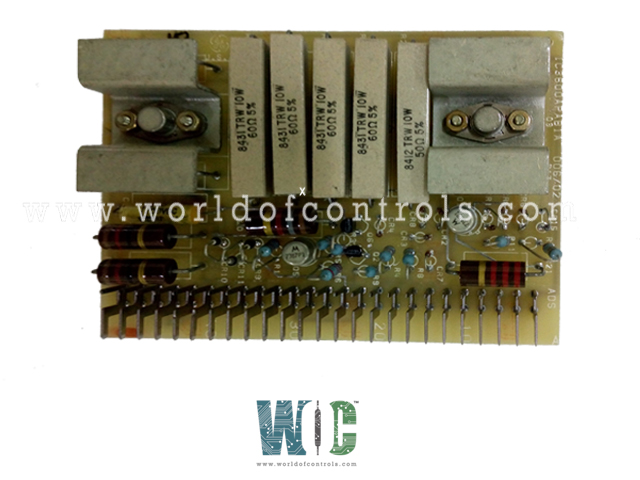SPECIFICATIONS
Part No: IC3600APAB1
Manufacturer: General Electric
Function: Power Amplifier Board
Series: Mark I & II
Repair: 3-7 Day
Availability: In Stock
Country of Manufacturer: United States (USA)
Functional Description
IC3600APAB1 is a Power Amplifier Board developed by GE. It is a part of Mark I & II control system. A power amplifier board is a circuit board that is designed specifically for amplifying electrical signals to a higher power level. The key function of a power amplifier board is to take a low-power signal and increase its voltage, current, or both while maintaining the fidelity of the original signal. The amplification process allows the signal to drive speakers or other loads with sufficient power to produce sound or perform other tasks.
Key Features and Specifications
- Power Amplifier Board: It is a power amplifier board that is designed to amplify electrical signals within the control system, ensuring that these signals are transmitted with the necessary power and accuracy to control actuators, motors, and other components. This is particularly important in systems like Mark I & II where power stability and signal integrity are crucial for maintaining operational safety and efficiency.
- Impedance: It has an impedance rating of 60 ohms, which is a key specification determining the compatibility of the amplifier with other components in the control system. This impedance rating ensures optimal power transmission and signal quality, preventing losses and ensuring that the signals are correctly processed by the downstream components.
- Power Rating: The board is rated for a power output of 10 watts, making it suitable for controlling moderate-power actuators and other control devices in the Mark I & II systems. The 10-watt power rating ensures that provides sufficient amplification to meet the system's requirements without being underpowered, contributing to the overall reliability and responsiveness of the control system.
- Application in Mark I & II Control Systems: It is specifically designed for use in the Mark I & II control systems, which are part of GE’s legacy digital control systems. These systems are widely used in power plants and industrial environments for controlling critical equipment, including turbines, generators, and other heavy machinery. The power amplifier board ensures that the control signals sent to actuators and other output devices are strong enough to drive the necessary actions, contributing to the precise regulation of the system.
- Signal Amplification: One of the primary functions is to amplify low-level control signals into higher power levels that can be used by various industrial components. This capability is essential in a control system where the accuracy of output actions depends on the clarity and strength of input signals. By boosting these signals, ensures that actuators and other output devices respond correctly to system commands.
- Durability and Reliability: Like all components designed for industrial control systems, the board is built to be highly durable and reliable. It is designed to withstand harsh operating conditions, including temperature variations, vibrations, and electrical interference that are common in power generation and industrial environments. This reliability ensures that it will continue to operate effectively over time, contributing to the overall uptime and performance of the system.
- Compact Design: Designed to be compact, making it easy to integrate into the larger control panel or system cabinet without taking up excessive space. Despite its small form factor, it delivers the necessary power amplification to ensure the smooth functioning of the Mark I & II control systems, contributing to both the efficiency and space-saving aspects of the installation.
Benefits and Applications
- Enhanced Signal Transmission: By amplifying signals, enhances the quality and strength of the control system’s output. This ensures that signals are transmitted effectively across the control system, improving overall performance and reducing the chances of signal degradation.
- Improved System Performance: With its ability to amplify power signals, contributes to the Mark I & II systems’ precision and accuracy. Whether it's controlling turbine speed or managing other mechanical systems, the power amplifier board ensures that control signals are delivered with the necessary power to execute commands accurately.
- Stability and Efficiency in Power Plants: In power generation environments where stability and efficiency are critical, ensures that power control signals are amplified correctly. This leads to better overall system control, reducing the potential for system failure and enhancing the operational efficiency of power plants or any industrial application relying on the Mark I & II systems.
WOC is happy to assist you with any of your GE requirements. Please contact us by phone or email for pricing and availability on any parts and repairs.
FREQUENTLY ASKED QUESTIONS
What is IC3600APAB1?
It is a Power Amplifier Board developed by GE
What is the difference between a power amplifier board and a regular amplifier?
A power amplifier board is a specific type of amplifier designed to amplify electrical signals to a higher power level, typically for applications like audio amplification or radio frequency transmission.
What are the different amplification classes, and how do they impact amplifier boards?
Power amplifiers are classified into various classes (e.g., Class A, Class AB, and Class D) based on their operating characteristics. The class of the amplifier affects factors like power efficiency, linearity, and distortion. Each class has its advantages and is chosen based on specific application requirements.
Are there any safety precautions to take when working with power amplifier boards?
When working with power amplifiers, always follow safety guidelines provided by the GE manufacturer. Disconnect power sources when making connections or adjustments, avoid overloading the amplifier, and be cautious of electrical hazards. If you're unsure about any aspect of installation or usage, consult the amplifier's user manual or seek professional assistance.
